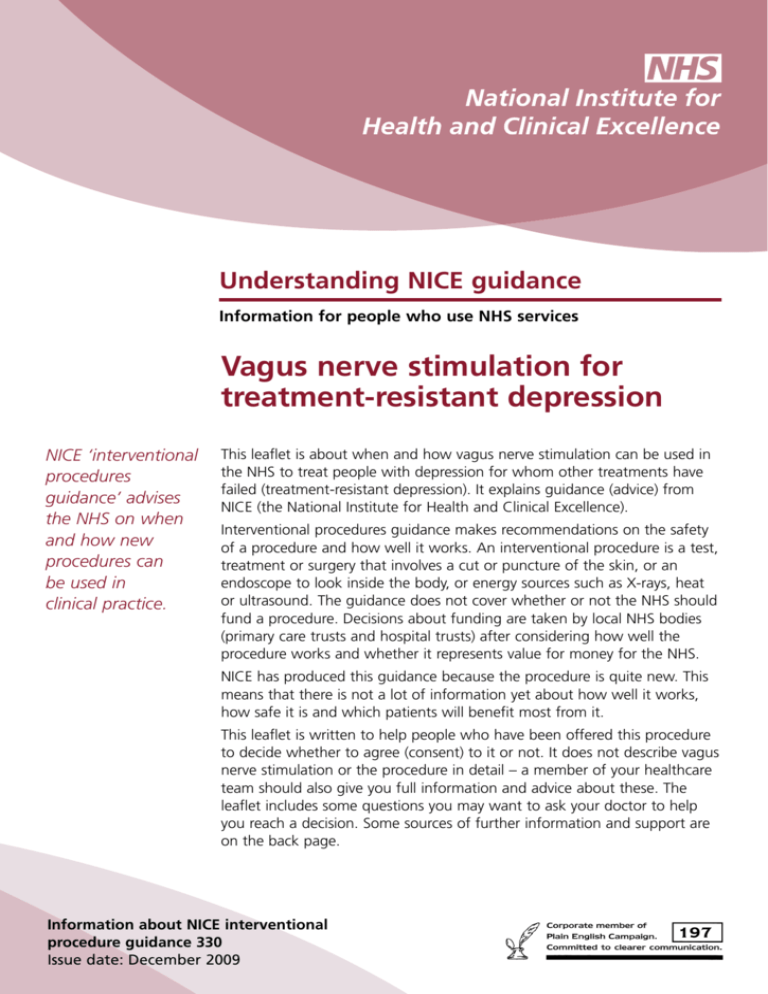
Understanding NICE guidance
Information for people who use NHS services
Vagus nerve stimulation for
treatment-resistant depression
NICE ‘interventional
procedures
guidance’ advises
the NHS on when
and how new
procedures can
be used in
clinical practice.
This leaflet is about when and how vagus nerve stimulation can be used in
the NHS to treat people with depression for whom other treatments have
failed (treatment-resistant depression). It explains guidance (advice) from
NICE (the National Institute for Health and Clinical Excellence).
Interventional procedures guidance makes recommendations on the safety
of a procedure and how well it works. An interventional procedure is a test,
treatment or surgery that involves a cut or puncture of the skin, or an
endoscope to look inside the body, or energy sources such as X-rays, heat
or ultrasound. The guidance does not cover whether or not the NHS should
fund a procedure. Decisions about funding are taken by local NHS bodies
(primary care trusts and hospital trusts) after considering how well the
procedure works and whether it represents value for money for the NHS.
NICE has produced this guidance because the procedure is quite new. This
means that there is not a lot of information yet about how well it works,
how safe it is and which patients will benefit most from it.
This leaflet is written to help people who have been offered this procedure
to decide whether to agree (consent) to it or not. It does not describe vagus
nerve stimulation or the procedure in detail – a member of your healthcare
team should also give you full information and advice about these. The
leaflet includes some questions you may want to ask your doctor to help
you reach a decision. Some sources of further information and support are
on the back page.
Information about NICE interventional
procedure guidance 330
Issue date: December 2009
What has NICE said?
There is not much good evidence about how well this procedure
works or how safe it is. If a doctor wants to use vagus nerve
stimulation for treatment-resistant depression, they should make sure
that extra steps are taken to explain the uncertainty about how well it
works, and the uncertainty surrounding potential risks of the
procedure. This should happen before the patient agrees (or doesn’t
agree) to the procedure. The patient should be given this leaflet and
other written information as part of the discussion. There should also
be special arrangements for monitoring what happens to the patient
after the procedure. The procedure should only be used in patients
for whom other treatments have failed.
A team of specialist clinicians should decide which patients should be
offered this procedure, and should also look after them. The team
should include a psychiatrist and a surgeon (usually a neurosurgeon),
with other relevant specialists, for example a clinical psychologist and
a trained technician.
NICE has encouraged further research into this procedure and may
review the procedure if more evidence becomes available.
Vagus nerve stimulation
This procedure may
not be the only
possible treatment
for treatmentresistant depression.
Your healthcare
team should talk to
you about whether
it is suitable for you
and about any
other treatment
options available.
The procedure is not described in detail here – please talk to your specialist
for a full description.
Depression causes feelings of sadness, hopelessness and lack of interest in
life. People with severe depression may be unable to eat or sleep or to take
part in social activities. Sometimes they harm themselves, have thoughts
about suicide, or may attempt suicide. They may also have hallucinations
and delusions.
Treatments for depression include antidepressant medicines, psychological
therapies including cognitive behavioural therapy (CBT) or a combination of
these. If the depression does not respond to other treatments (known as
treatment-resistant depression), electroconvulsive therapy (ECT) may be used.
The aim of this procedure is to improve mood and reduce depression by
stimulating the vagus nerve, which carries impulses to the area of the brain
involved in mood regulation. The procedure is carried out with the patient
under a general or local anaesthetic. The surgeon makes a small cut on the
left side of the neck and places an electrical stimulator around the vagus
nerve. The wires from the stimulator are passed down through the chest to
a device like a pacemaker, which is inserted through a cut in the chest wall.
The device is then set up to produce the electrical impulses.
Summary of possible benefits and risks
Some of the benefits and risks seen in the studies considered by NICE are
briefly described here. NICE looked at 7 studies on this procedure, but
it was not clear whether some patients had been reported on in more
than 1 study.
Information about NICE interventional procedure guidance 330
What does this mean for me?
If your doctor has offered you this procedure, he or she should tell you
that NICE has decided that the benefits and risks are uncertain. This
does not mean that the procedure should not be done, but that your
doctor should fully explain what is involved and discuss the possible
benefits and risks with you. You should only be asked if you want to
agree to this procedure after this discussion has taken place. You should
be given written information, including this leaflet, and have the
opportunity to discuss it with your doctor before making your decision.
NICE has also decided that more information is needed about this
procedure. Your doctor may ask you if details of your procedure can be
used to help collect more information, and will give you more
information about this.
You may want to ask the questions below
• What does the procedure involve?
• What are the benefits I might get?
• How good are my chances of getting those benefits? Could having
the procedure make me feel worse?
• Are there alternative procedures?
• What are the risks of the procedure?
• Are the risks minor or serious? How likely are they to happen?
• What care will I need after the operation?
• What happens if something goes wrong?
• What may happen if I don’t have the procedure?
How well does the procedure work?
Depression was scored using the Hamilton Depression Rating Scale. An
analysis of 18 studies involving a total of up to 1251 patients who had
vagus nerve stimulation reported that the procedure gave a satisfactory
response in up to 58% of patients in studies lasting 12 months or more. In
a study in which 112 patients had vagus nerve stimulation and 110 patients
had a sham (placebo) treatment, patients’ depression scores were not
significantly different between the 2 groups. In a study of 74 patients with
severe depression, patients’ depression scores had improved significantly
when their progress was checked 1 year after the procedure. The study
showed that 55% of patients had a response to vagus nerve stimulation.
You might decide
to have this
procedure, to
have a different
procedure, or
not to have a
procedure at all.
As well as looking at these studies, NICE also asked expert advisers for their
views. These advisers are clinical specialists in this field of medicine. The
advisers said that success factors are improved depression scale scores,
quality of life and a reduced need for antidepressant medication or
support services.
Information about NICE interventional procedure guidance 330
Risks and possible problems
In the analysis of 18 studies, 1 study reported serious or medically important
problems in 10 out of 59 patients receiving vagus nerve stimulation (exact
details not reported) and that 2 patients’ depression had worsened. In 6 studies
in the analysis, 2 patients stopped treatment because of problems (no more
detail was given). In the study of 74 patients, 2 patients had committed suicide
by 12 months after the procedure. Three studies reported problems after vagus
nerve stimulation, such as manic episodes and worsening depression.
In the study of 74 patients, 10% reported shortness of breath, 20% reported
pain, 26% reported a cough and 63% reported changes to their voices when
their progress was checked after 3 months.
As well as looking at these studies, NICE also asked expert advisers for their
views. These advisers are clinical specialists in this field of medicine. The
advisers said that problems with speech and hoarseness are possible. In theory,
other problems could include cardiac arrest, heart rhythm problems, cognitive
disturbances, vocal cord paralysis, diarrhoea and inflammation at the site of
the procedure.
More information about depression
NHS Choices (www.nhs.uk) may be a good place to find out more. Your local
patient advice and liaison service (usually known as PALS) may also be able to give
you further information and support. For details of all NICE guidance on depression,
visit our website at www.nice.org.uk
About NICE
NICE produces guidance (advice) for the NHS about preventing, diagnosing and treating different
medical conditions. The guidance is written by independent experts including healthcare
professionals and people representing patients and carers. They consider how well an
interventional procedure works and how safe it is, and ask the opinions of expert advisers.
Interventional procedures guidance applies to the whole of the NHS in England, Wales, Scotland
and Northern Ireland. Staff working in the NHS are expected to follow this guidance.
To find out more about NICE, its work and how it reaches decisions, see
www.nice.org.uk/aboutguidance
This leaflet is about ‘vagus nerve stimulation for treatment-resistant depression’. This leaflet and
the full guidance aimed at healthcare professionals are available at www.nice.org.uk/IPG330
You can order printed copies of this leaflet from NICE publications (phone 0845 003 7783 or
email publications@nice.org.uk and quote reference N2069). The NICE website has a screen
reader service called Browsealoud, which allows you to listen to our guidance. Click on the
Browsealoud logo on the NICE website to use this service.
We encourage voluntary organisations, NHS organisations and clinicians to use text from this
booklet in their own information about this procedure.
National Institute for Health and Clinical Excellence
MidCity Place, 71 High Holborn, London, WC1V 6NA; www.nice.org.uk
© National Institute for Health and Clinical Excellence, 2009. All rights reserved. This material may be freely
reproduced for educational and not-for-profit purposes. No reproduction by or for commercial organisations,
or for commercial purposes, is allowed without the express written permission of NICE.
ISBN 978-1-84936-150-7
N2069 1P Dec 09







